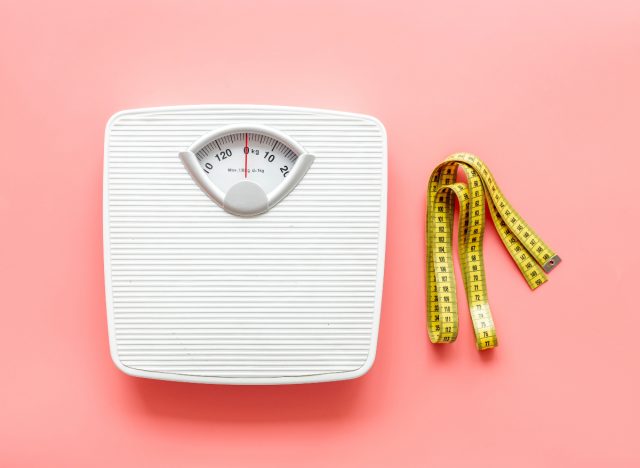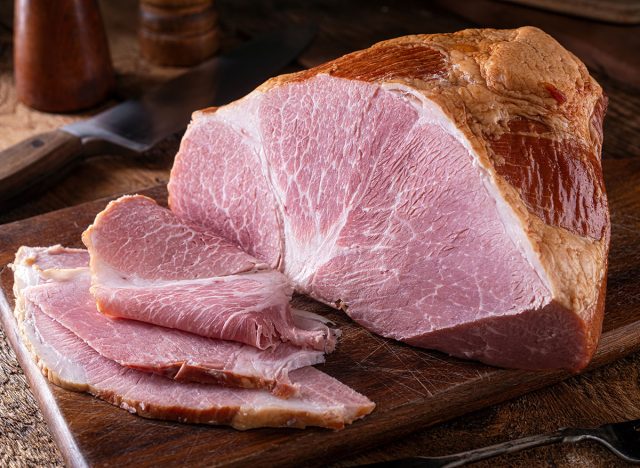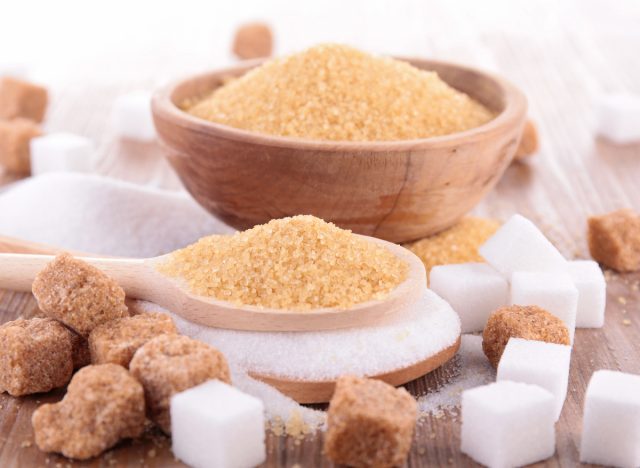What Happens to Your Body When You Eat Ham

Pork is the most widely eaten meat in the world, according to the USDA. And it's especially common on Christmas, as ham makes for a festive holiday dinner centerpiece. Whether this popular protein is on your menu every week or you prefer to slice into a roast only on special occasions, ham can make for a healthy meal that's high in protein and other important nutrients—but it all depends on the type of ham you choose and how you cook it.
Here, Katherine Brooking, MS, RD, a New York-based registered dietitian, explains what happens to your body when you eat ham. And if you're cooking up the protein this Christmas, consider pairing it with one of these 10 Tasty Side Dishes for Your Holiday Ham.
It Can Help You Build Lean Muscle

If your goal is to gain muscle, you'll want to pair your strength-training workouts with a high-protein diet. The American College of Sports Medicine recommends eating 0.5 to 0.8 grams of protein per pound of body weight every day, and ham could easily help you reach your goal.
Ham is a source of protein and contains all nine essential amino acids, making it a complete protein, Brooking says. "Amino acids are the building blocks of muscle tissue and help build and maintain muscle mass, and essential amino acids must be obtained through diet," Brooking says. A small 3-ounce serving of roasted ham contains an impressive 23 grams of complete protein, according to the USDA.
It Might Help You Lose Weight

If you're looking to lose weight or maintain your weight loss for the long haul, you'll want to prioritize protein in every meal. And ham might help here because it's a solid source of protein. "Research indicates that eating protein can help you feel fuller for longer periods of time, thereby reducing the likelihood of cravings and overeating," Brooking says.
Not only that, but "protein is essential for building and maintaining muscle mass, and having more muscle tissue means that you'll burn more calories than if you had more fat tissue," Brooking says. Ham is also relatively low in calories: A 3-ounce serving has about 230 calories. Pair it with cooked quinoa and a side salad for a high-protein meal that will keep you full and help maintain lean muscle.
Smoked and Cured Hams Might Contribute to Inflammation and Disease Risk

Many hams come smoked or cured, which adds major flavor to the meat but also contributes some unhealthy properties that can contribute to a higher disease risk through multiple mechanisms. "Both curing and smoking are forms of processing that have been linked to increases in certain types of carcinogens," Brooking says.
"Many health agencies, including the American Cancer Society, recommend limiting intake of processed meat (including ham) as they are correlated with a higher risk of some cancers, including stomach and colorectal and other cancers," Brooking says.
Here's why: Processed ham usually contains nitrates. Although the research is mixed, some studies show increases in colon, kidney, and stomach cancers with a higher nitrate intake.
What's more, meats like ham that are cooked at high temperatures produce inflammation-associated compounds called AGEs or advanced glycation end products, according to a 2016 report in the journal Critical Reviews in Food Science and Nutrition. "AGEs have been linked to increases in diabetes, heart disease, and some cancers," Brooking says.
Smoked and Cured Hams Can Contribute to Heart Issues

Cured and smoked ham also tends to be high in sodium. Take this: A 3-ounce serving of cured ham packs 800 milligrams of sodium, or about 33 percent of your daily value. For some folks, a high-sodium diet can increase blood pressure, Brooking says. High blood pressure can lead to a higher risk of heart attack or stroke, according to the Mayo Clinic.
If you choose to add ham to your diet, go for fresh ham. "Typically, fresh ham contains less sodium and fewer cancer-causing compounds than cured or smoked ham," Brooking says.
You'll Get Important Micronutrients

Many Americans aren't meeting their recommended micronutrient intakes, which can lead to fatigue, reduced attention and focus, and a lower immune system, among other sneaky symptoms, per Oregon State University.
But ham, like other types of red meat, is a good source of plenty of vitamins and minerals.
A 3-ounce serving of roasted ham contains 20% of your daily value (DV) of immune-supporting zinc, 70% of your DV of metabolism-supporting selenium, and is an excellent source of energizing B vitamins.
You May Take in Too Much Added Sugar

Some hams come honey-roasted, and while that may make your holiday roast more succulent, it'll also contribute added sugar to your day. A 3-ounce serving of honey ham contains around 5 grams of added sugars. While that doesn't seem like a lot, the American Heart Association (AHA) recommends limiting your added sugar intake to only 25 grams for women and 36 grams for men per day. And forking into a serving of honey ham can give you about 20 percent of your daily value of added sugar. Eating too much added sugar too often can increase your risk for heart disease and diabetes, per the AHA.
- Source: U.S. Department of Agriculture. (2023, March 22). What is the most consumed meat in the world? AskUSDA. Retrieved December 18, 2023, from https://ask.usda.gov/s/article/What-is-the-most-consumed-meat-in-the-world
- Source: ACSM Blog. (2020, September 14). ACSM_CMS. https://www.acsm.org/blog-detail/acsm-certified-blog/2020/09/14/how-much-protein-for-muscle-repair-growth-maintenance
- Source: Nutrition facts for roasted ham. (n.d.). Myfooddata. https://tools.myfooddata.com/nutrition-facts/168223/wt2/1
- Source: Moon J, Koh G. Clinical Evidence and Mechanisms of High-Protein Diet-Induced Weight Loss. J Obes Metab Syndr. 2020 Sep 30;29(3):166-173. doi: 10.7570/jomes20028. PMID: 32699189; PMCID: PMC7539343.
- Source: Bouvard V, Loomis D, Guyton KZ, Grosse Y, Ghissassi FE, Benbrahim-Tallaa L, Guha N, Mattock H, Straif K; International Agency for Research on Cancer Monograph Working Group. Carcinogenicity of consumption of red and processed meat. Lancet Oncol. 2015 Dec;16(16):1599-600. doi: 10.1016/S1470-2045(15)00444-1. Epub 2015 Oct 29. PMID: 26514947.
- Source: Turesky RJ. Mechanistic Evidence for Red Meat and Processed Meat Intake and Cancer Risk: A Follow-up on the International Agency for Research on Cancer Evaluation of 2015. Chimia (Aarau). 2018 Oct 31;72(10):718-724. doi: 10.2533/chimia.2018.718. PMID: 30376922; PMCID: PMC6294997.
- Source: Nitrate. (n.d.). Cancer Trends Progress Report. https://progressreport.cancer.gov/prevention/nitrate
- Source: Davis KE, Prasad C, Vijayagopal P, Juma S, Imrhan V. Advanced Glycation End Products, Inflammation, and Chronic Metabolic Diseases: Links in a Chain? Crit Rev Food Sci Nutr. 2016;56(6):989-98. doi: 10.1080/10408398.2012.744738. PMID: 25259686.
- Source: Nutrition Facts for Cured ham. (n.d.). Myfooddata. https://tools.myfooddata.com/nutrition-facts/168281/wt2/1
- Source: High blood pressure (hypertension) - Symptoms & causes - Mayo Clinic. (2022, September 15). Mayo Clinic. https://www.mayoclinic.org/diseases-conditions/high-blood-pressure/symptoms-causes/syc-20373410
- Source: Micronutrient Inadequacies in the US Population: an Overview. (2023, January 3). Linus Pauling Institute. https://lpi.oregonstate.edu/mic/micronutrient-inadequacies/overview
- Source: Nutrition Facts for Meijer Inc. - Uncured Honey ham. (n.d.). Myfooddata. https://tools.myfooddata.com/nutrition-facts/546367/oz/3
- Source: How much sugar is too much? (2023, May 10). www.heart.org. https://www.heart.org/en/healthy-living/healthy-eating/eat-smart/sugar/how-much-sugar-is-too-much









